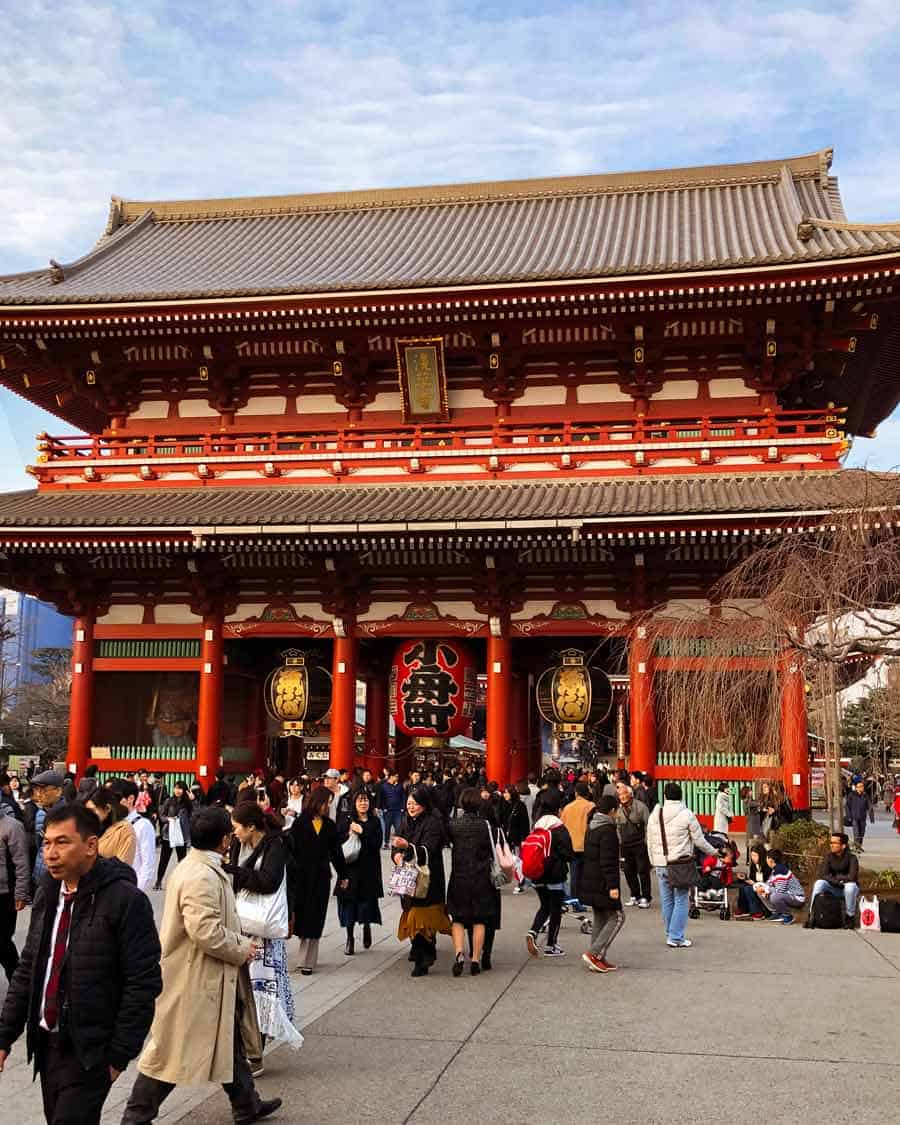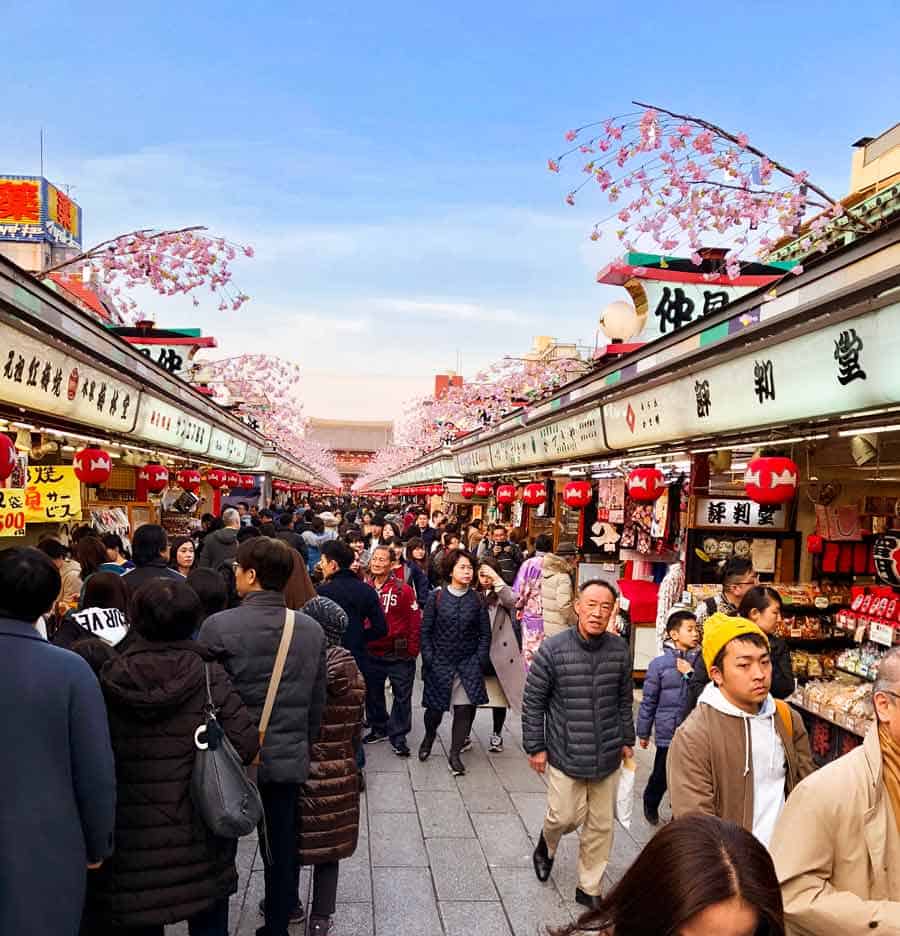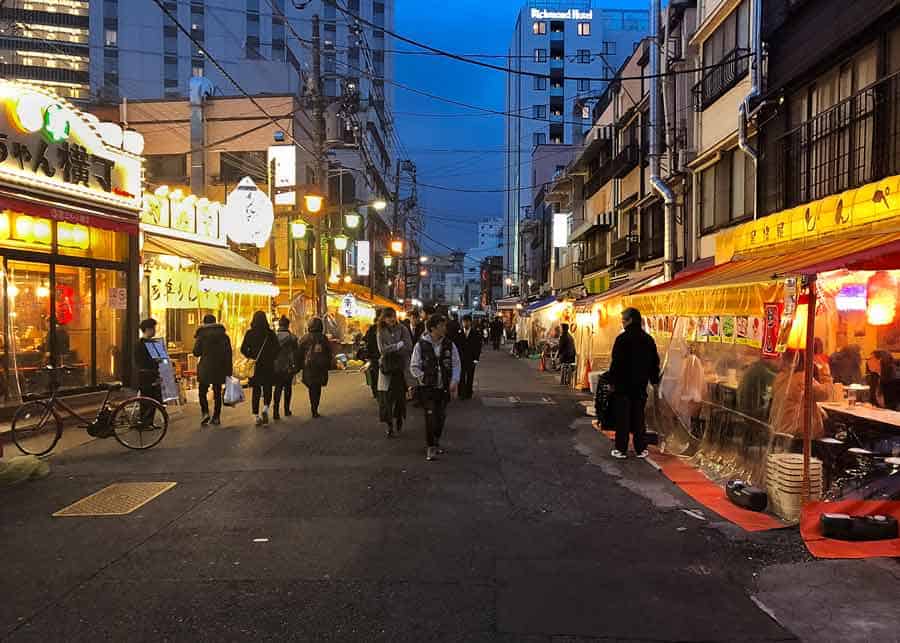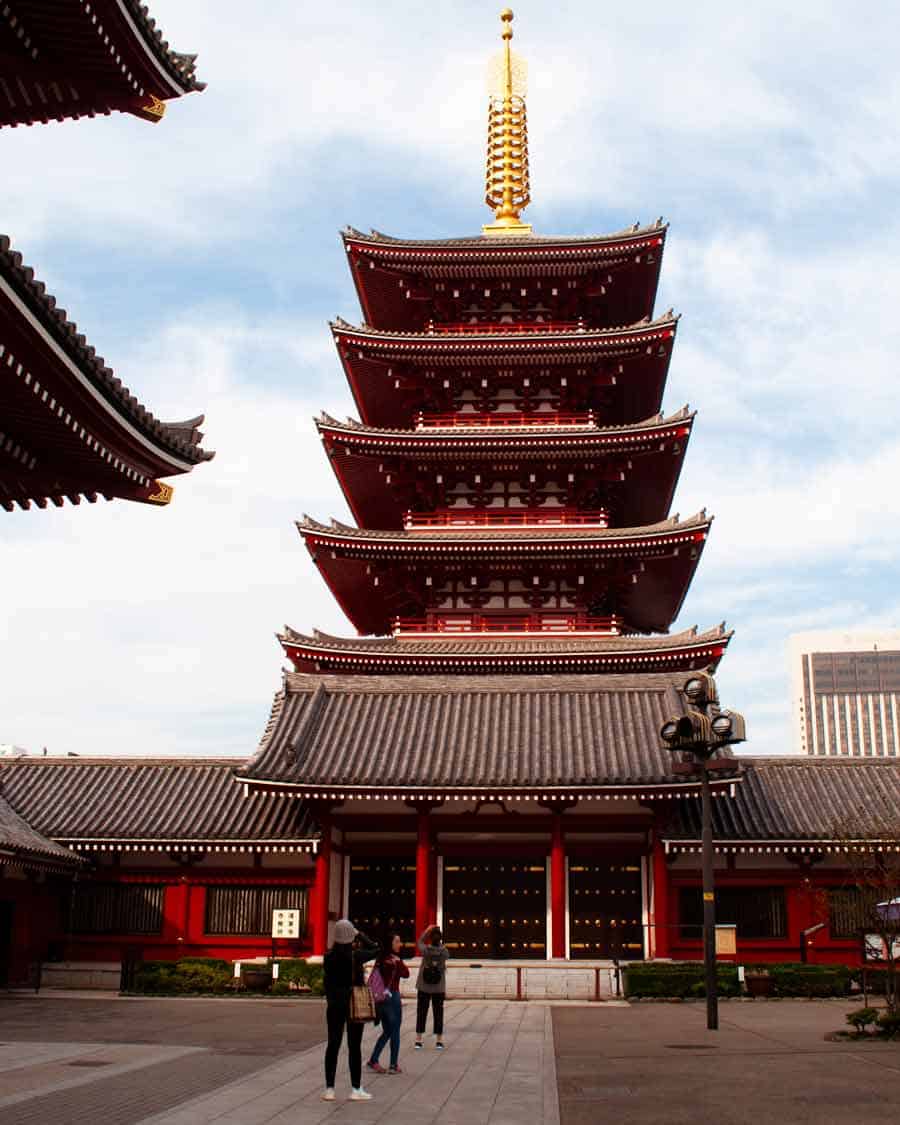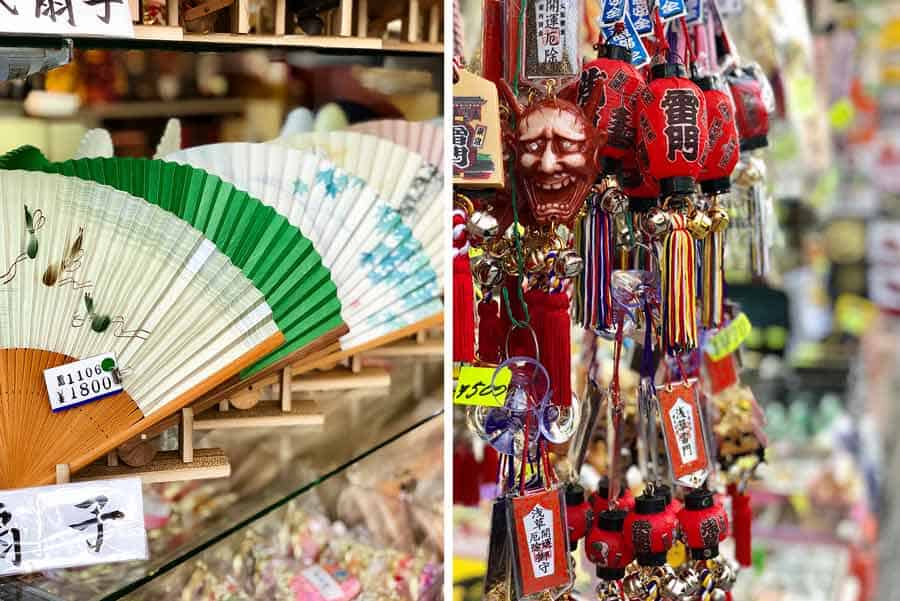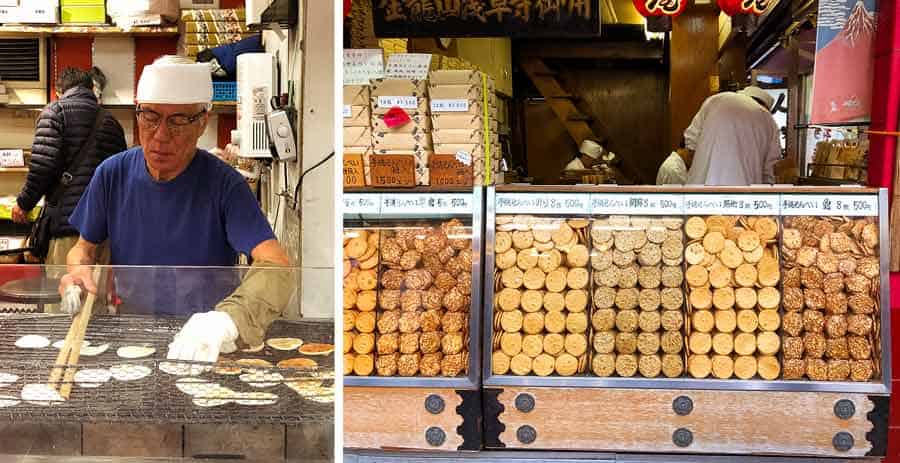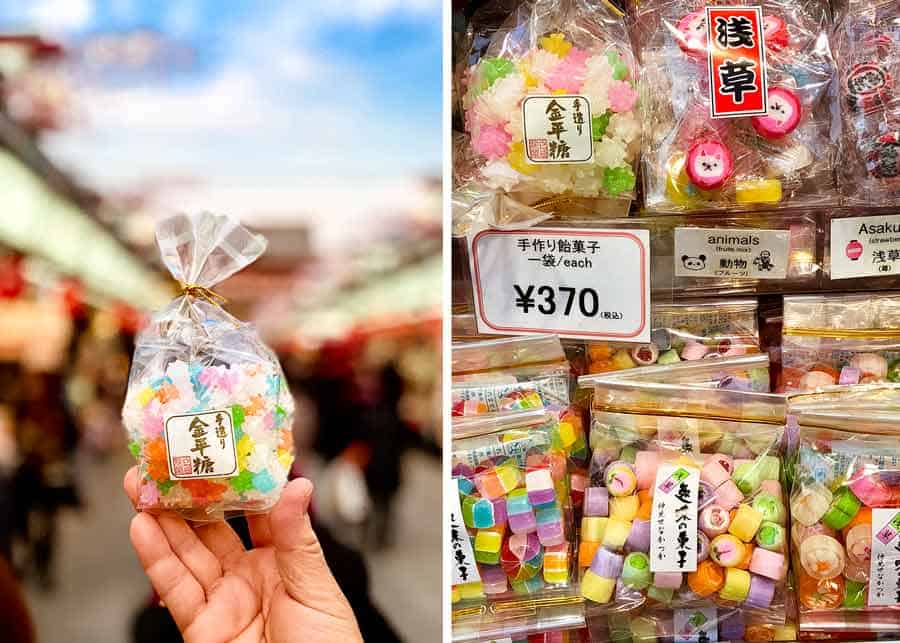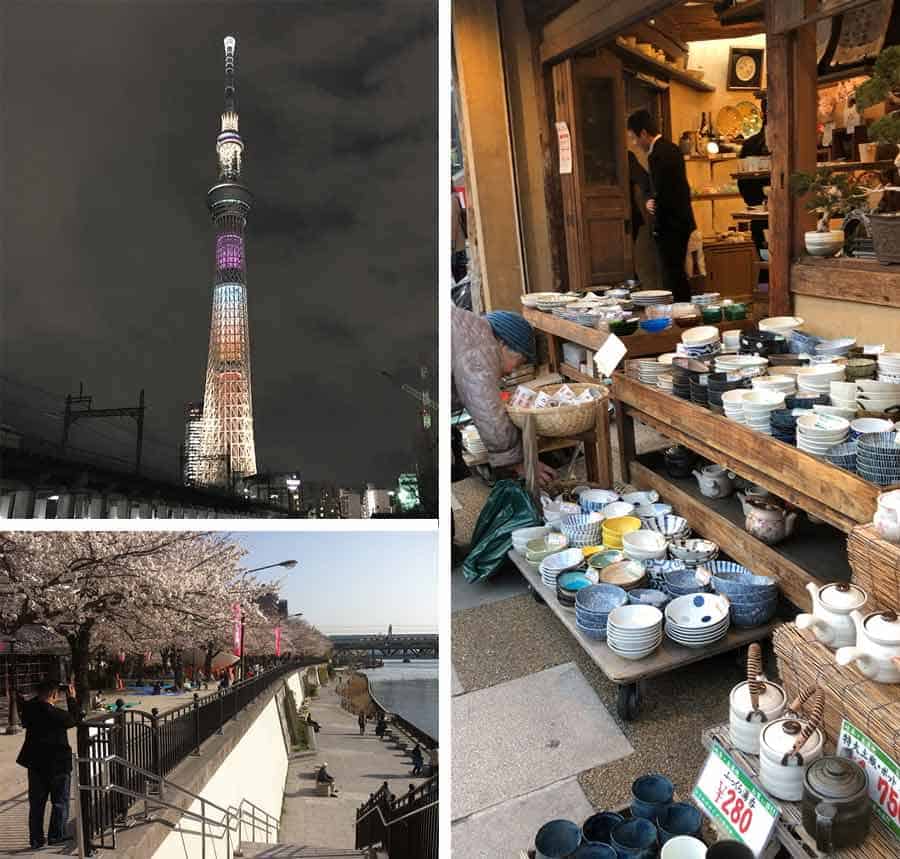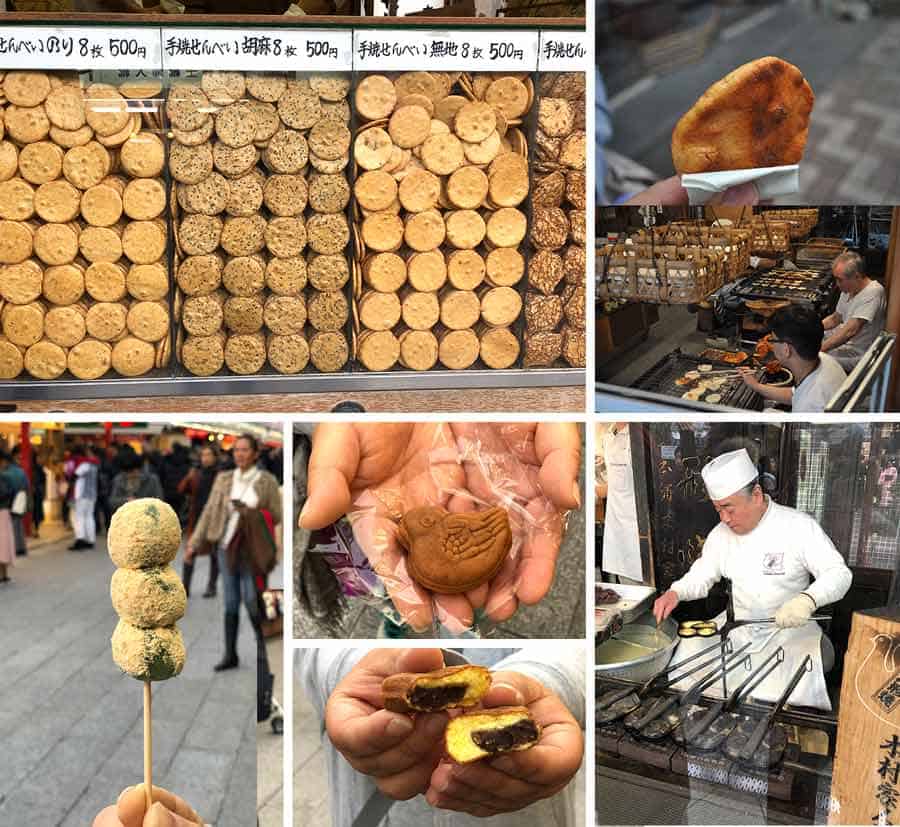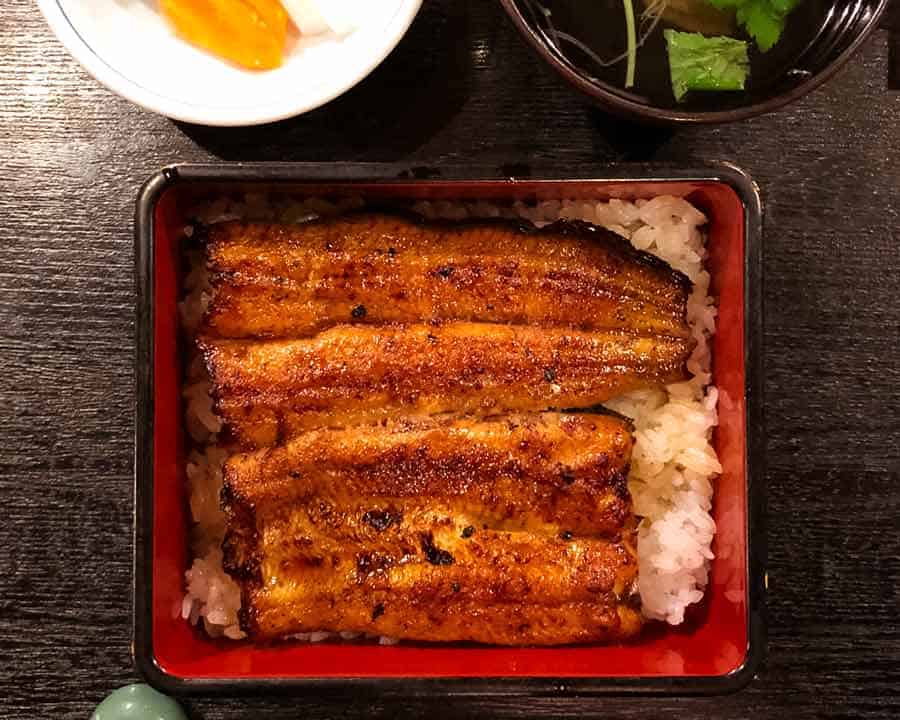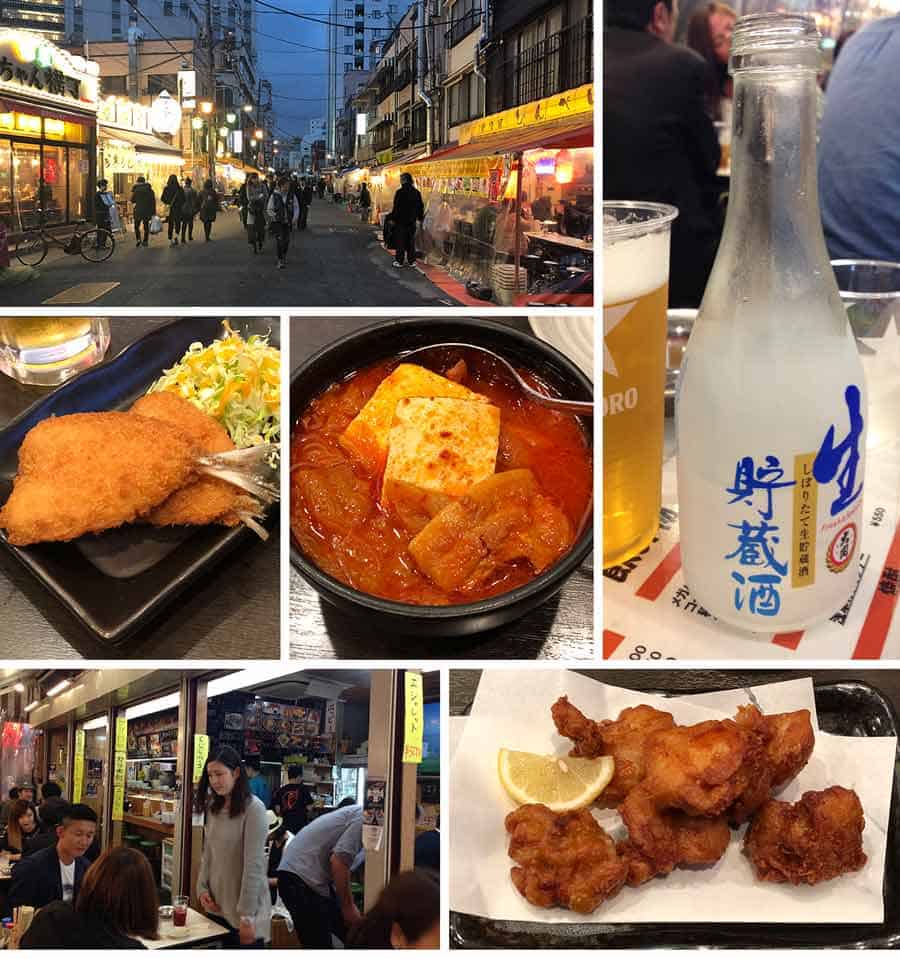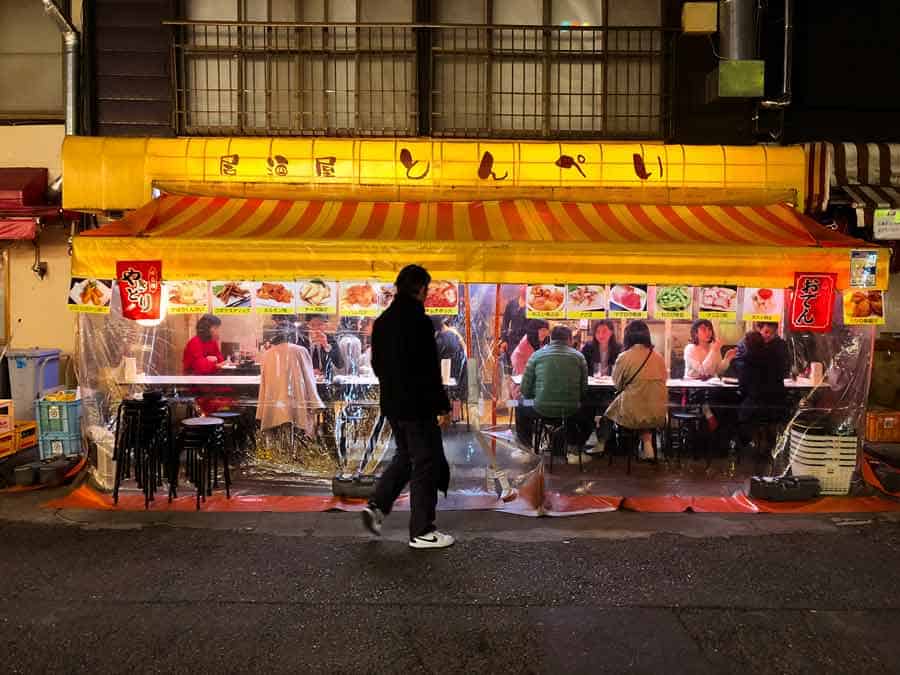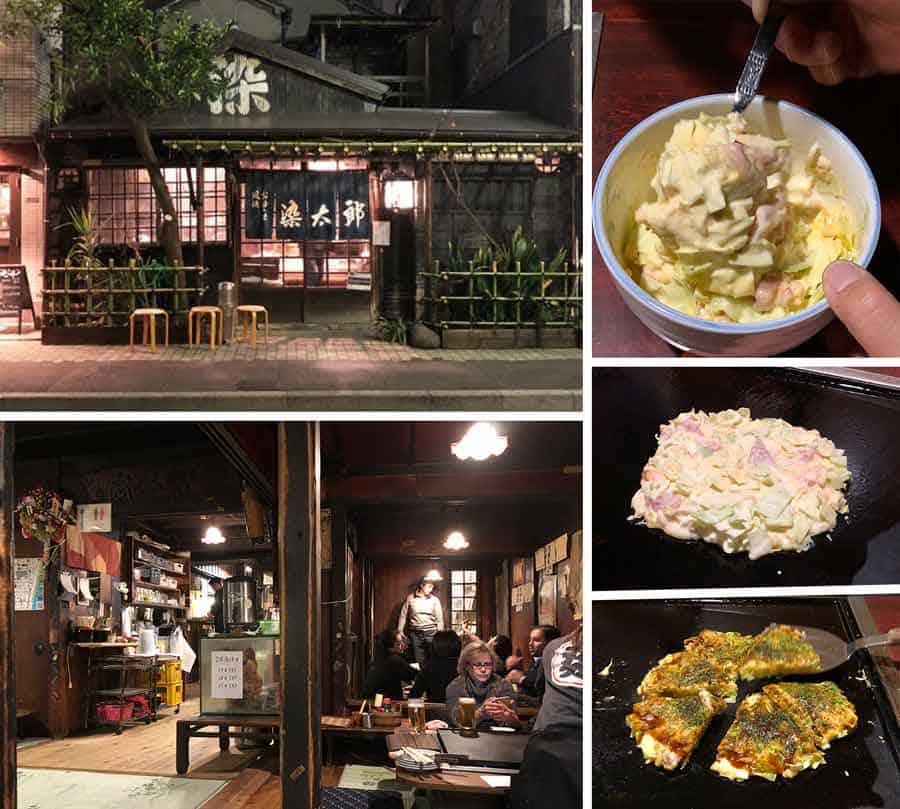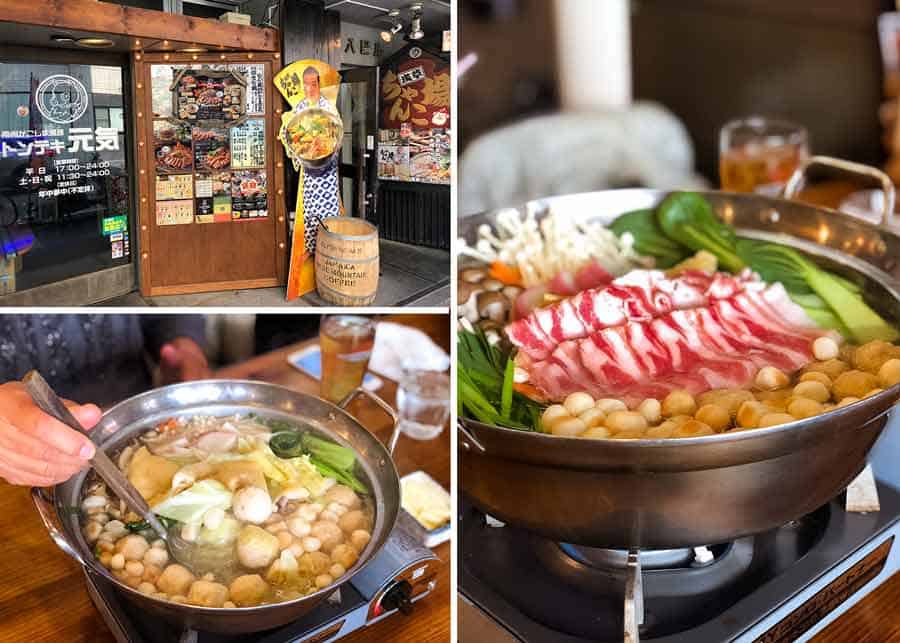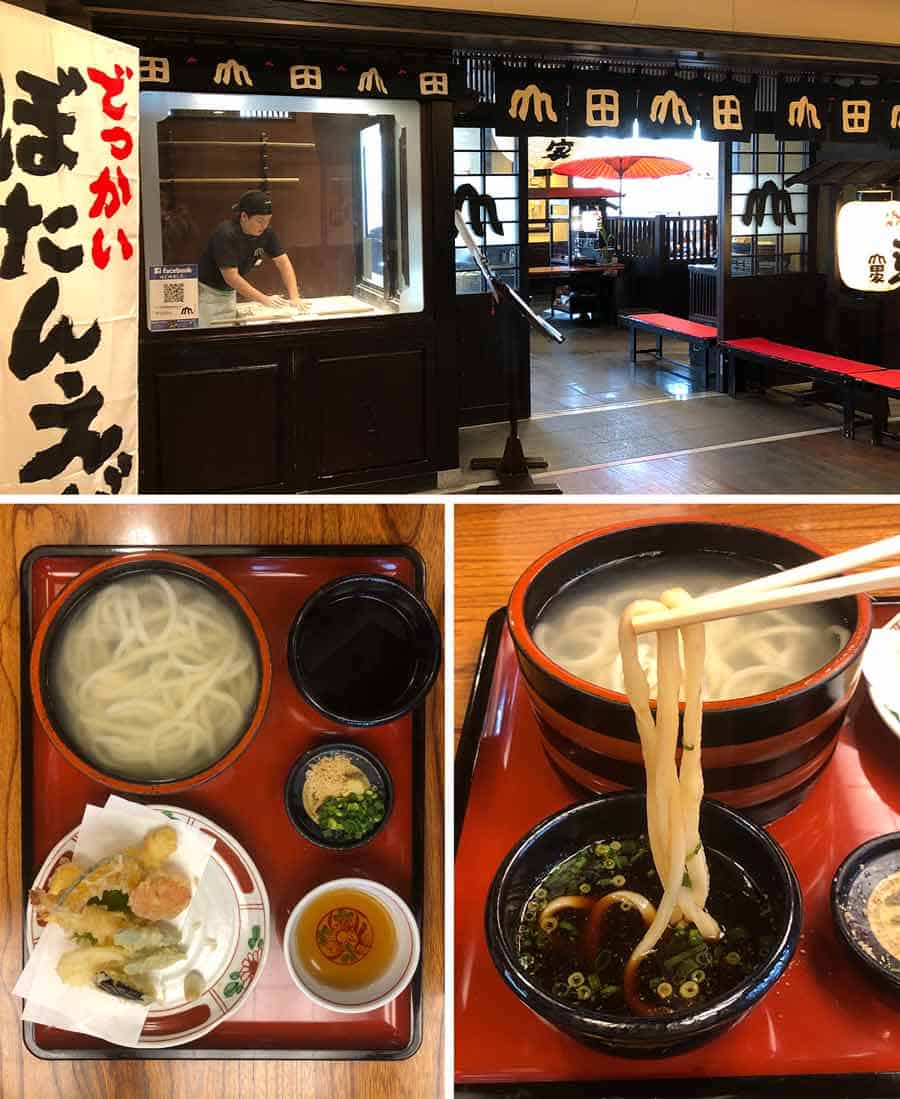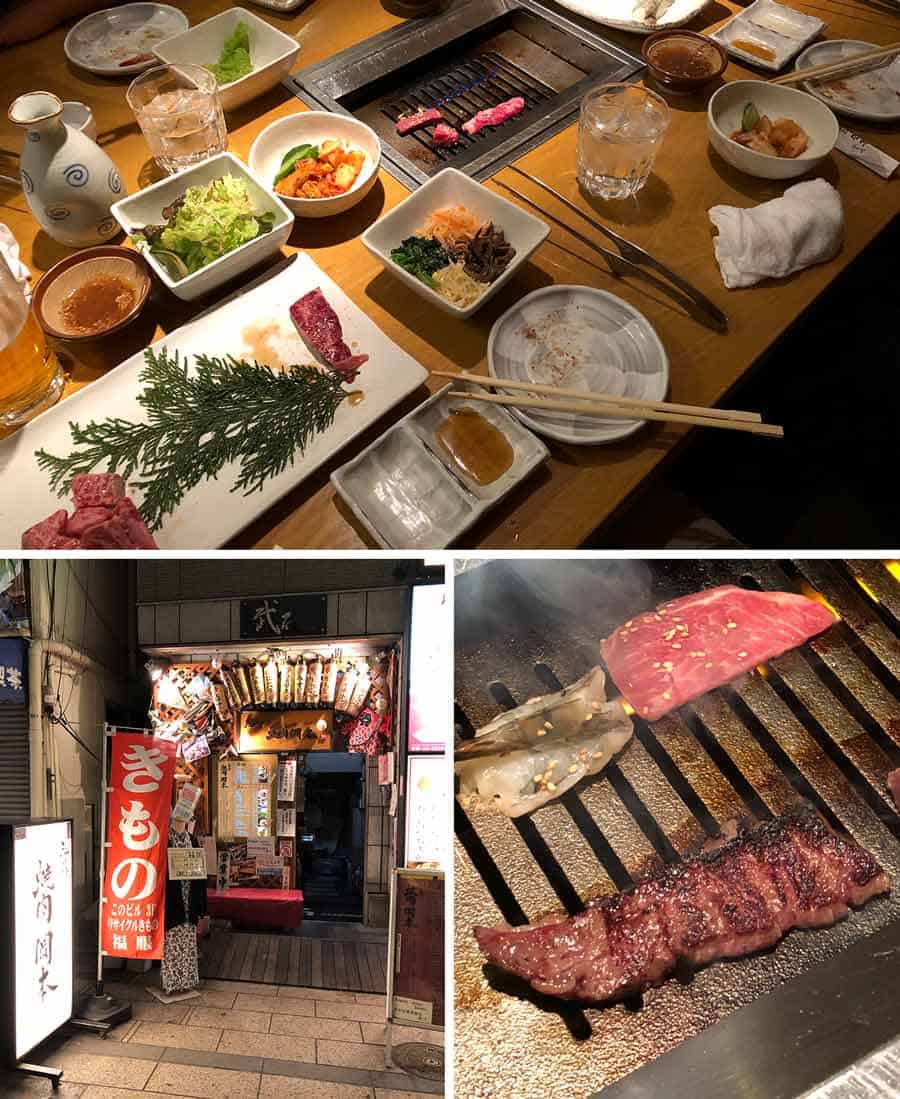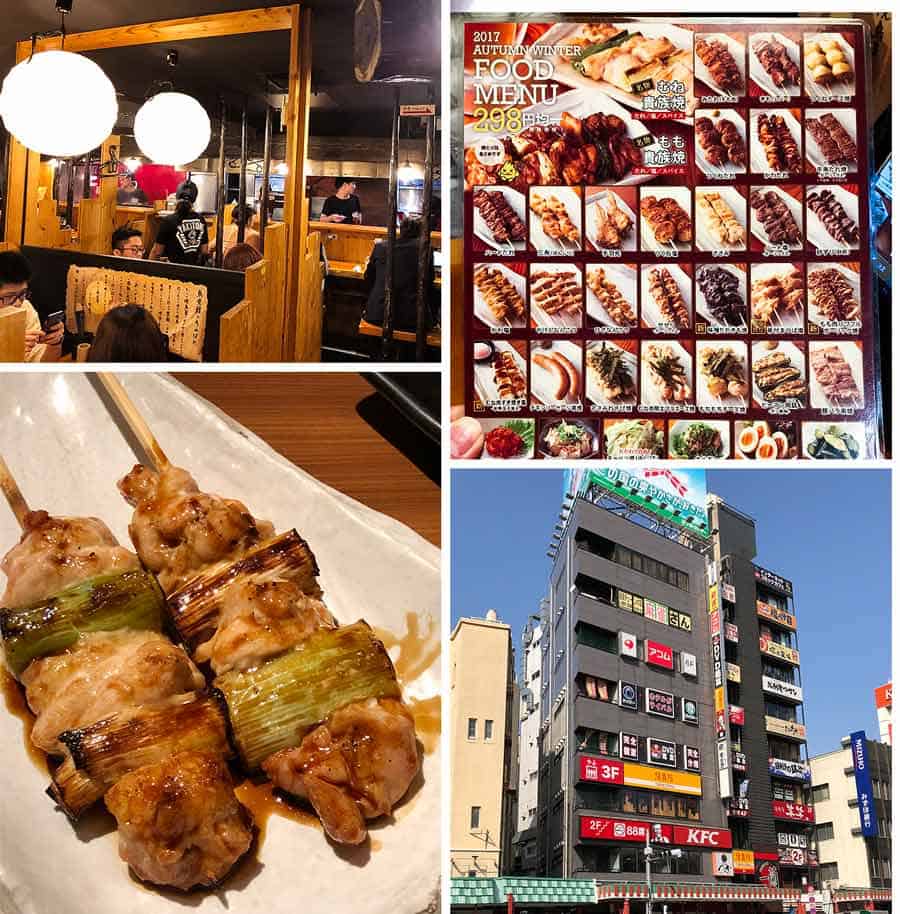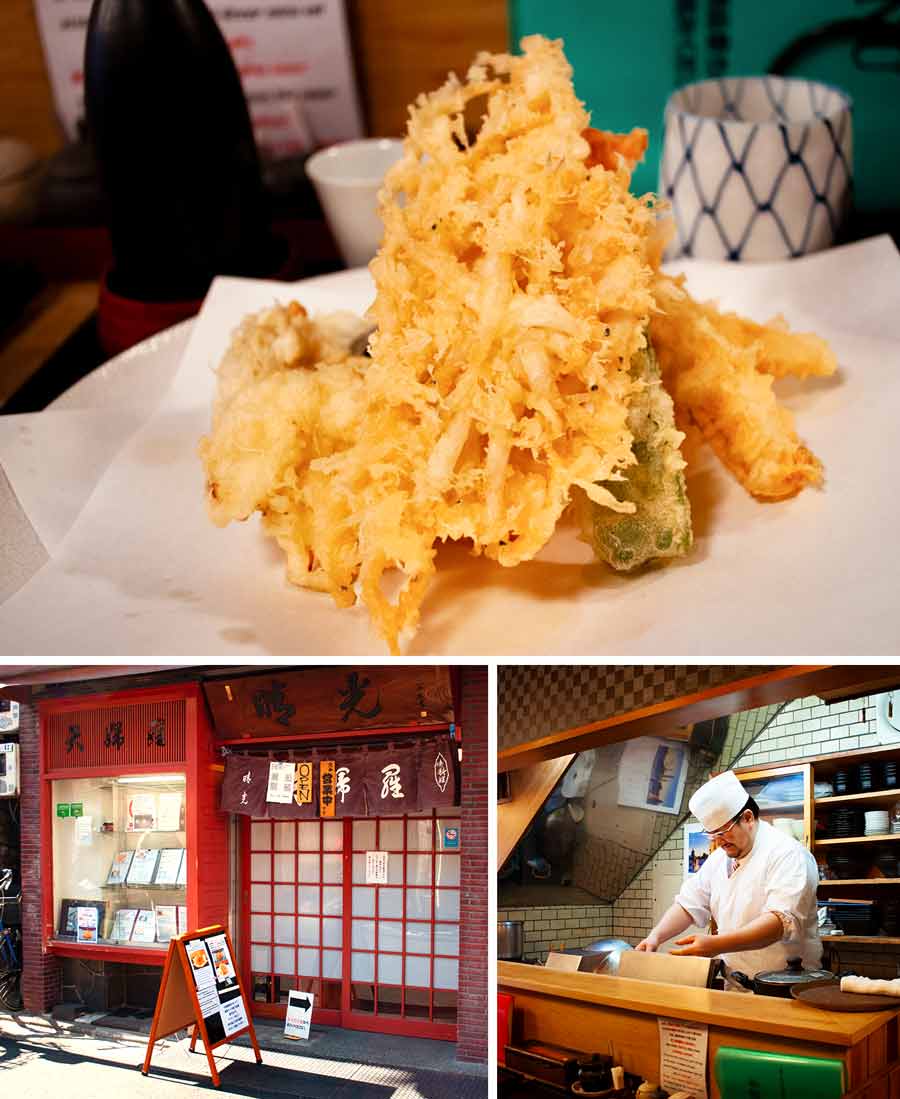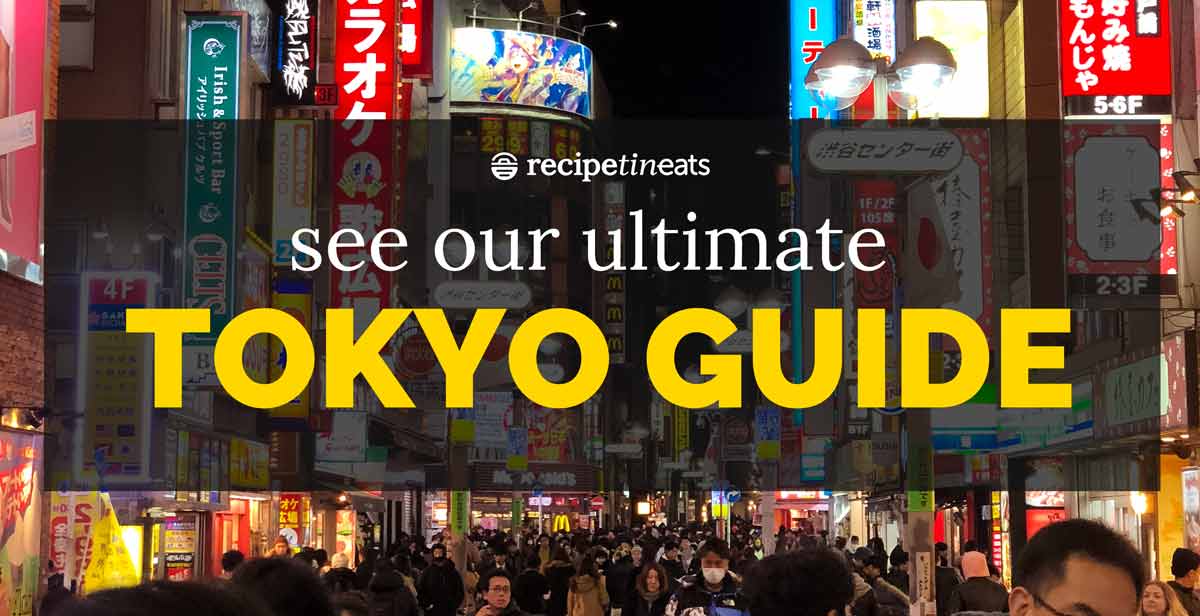Asakusa is one of the most popular areas for visitors to Tokyo! Centred around the famous Sensoji temple and Nakamise shopping street with its colourful stalls, this is a great place to just walk around to absorb the vibe, watch Japanese snacks being made by hand (and try them!) and enjoy the traditional atmosphere. Even though we’ve visited Asakusa dozens of times, we still go back every time we visit Tokyo – just because we love it!
Asakusa
While other parts of Tokyo like Shinjuku are bustling business districts with towering modern sky scrapers, the Asakusa area retains some of the traditional character of Tokyo and has a more relaxed atmosphere than other parts of the city. The heart of Asakusa is the temple precinct, where the Sensoji temple and other monuments, as well as the vibrant Nakamise shopping street that leads to the temple, reside. It’s a great area to explore at a slow pace, and there’s always something new to see or discover even on repeat visits. Also nearby and worth a visit is the famous Tokyo Skytree and Kappabashi “Kitchen Town”, it’s paradise for cooking enthusiasts!
What to do in Asakusa
Sensoji Temple
Sensoji Temple is a Buddhist temple and the focal point of the Asakusa area. It’s famous for being the oldest temple in the city – its origins even older than Tokyo itself – and is one of the most popular in the city owing to its grandness and the precinct in which it resides. The temple is not just a relic, but a genuine place of worship for the faithful. You’ll see everyday Japanese people visiting the temple to pay their respects, lighting incense candles and praying for good fortune. If you’re wondering if Sensoji Temple is open at night, yes it is. Though the temple’s main hall closes at 5pm (as do most Nakamise shops), you can still walk the temple grounds and see the building dramatically lit against the darkness of the night sky. How to get there: There are multiple approaches, but the easiest is through the huge Kaminarimon red gate near the Asakusa station exit, and then the temple is at the end of the Nakamise shopping street.
Nakamise shopping street
The huge Kaminarimon gate marks the traditional entrance to the temple precinct, easily identified by the giant hanging red lantern. Passing through the gate, you will be greeted by Nakamise shopping street, the main walk leading to the Sensoji temple. Dozens of shops and stalls line this street as well as the alleys that branch from it. Most Nakamise street shops sell tourist trinkets and souvenirs like fans and key chains.
You will find a number of stalls also selling traditional Japanese snacks, both savoury and sweet. Freshly handmade osenbei, the traditional Japanese rice crackers, are a particular favourite of ours. Plenty of pre-packaged Japanese snacks are also sold in the Nakamise strip. Colourful sugar candies like those pictured below make great gifts for friends and family back home! How to get there: The start of Nakamise shopping streets is just past the huge red Kaminarimon gate with the lantern, right near the Asakusa station exit!
Other Sights in Asakusa
While the Sensoji Temple and Nakamise shopping street are the two most popular attractions in Asakusa, there are other points of interest nearby that are worth visiting.
Tokyo Skytree – At 634m, this television tower is the tallest structure in Japan. It’s 1.5 km (1 mile) east of the Asakusa temple grounds, a 20 minute walk or one stop on the Tobu Skytree Line to the Tokyo Skytree Station or the subway from Asakusa Station to Oshiage station. There’s an observation deck as well as a large multi level shopping centre called Tokyo Solamachi “Sky Town”. Drum Museum – A few hundred metres south west of the temple district is the Taiko-Kan (Drum Museum), where you can check out some 600 different drums and bash away at some of them. Sumida Park – On the water’s edge to the east of the temple district, this pleasant stretch of space is a popular location for cherry blossom viewing in spring and also has good views of some of the area’s iconic monuments like the Asahi Beer Tower, with it’s golden flame sculpture (or golden radish, to some locals!) and Tokyo Skytree. Kappabashi “Kitchen Town” – A mere 10 minute walk from Sensoji Temple is a 1 km long stretch of road lined with endless shops selling every item imaginable related to kitchens, food preparation and restaurants. We visit Kappabashi without fail every time we visit Japan to stock up on Japanese crockery, cooking utensils, and specialist equipment. It is a paradise for anybody who loves cooking, especially Japanese food!
See the Asakusa map below for directions.
Best food in Asakusa
There is no shortage of excellent food in Asakusa and it is a great place to sample traditional Japanese dishes at some well known spots!
JAPANESE SNACKS
In the Nakamise and surrounding blocks in Asakusa, you can try a variety of traditional Japanese snacks and sweets. Keep an eye out for the following treats!
Osenbei – Rice crackers that come in many different seasonings and flavourings. Freshly cooked (as opposed to industrially made) osenbei are a particularly rare treat, so make sure you try one while you’re here! Ningyo-yaki – A sweet cake filled with anko (sweet red bean paste) or occasionally custard, pressed into the shape of a doll – hence the name, ningyo meaning “doll” – or other characters. Dango – Round balls of mochi (pounded sticky rice) topped with various flavourings such as soy bean flour, red bean paste, and sweet soy glaze. Menchi-katsu – Strictly speaking not a traditional snack, but so good we had to include it. Menchi-katsu are breaded and deep-fried croquettes of juicy mince meat. While they can be found across the city, Asakusa Menchi is a particularly famous shop selling these irresistible croquettes.
Nakamise Address: 1 Chome Asakusa, Taitō-ku, Tokyo (Map) Phone: +81 30384200181 Open: Many shops are open daily, 9:00-19:00 Website
UNAGI
Unagi are freshwater eels. The fillets are usually brushed with a soy glaze, grilled over charcoal and served on rice. Unagi is a traditional Japanese delicacy and there are quite a number of famous unagi restaurants in the Asakusa area with histories that span decades or even centuries. One such special restaurant is Komagata Maekawa, an unagi restaurant with a 200 year history. A traditional institution with tatami mat rooms, you can gaze over the Sumida River while feasting on expertly prepared unagi served over rice. There are two other branches around the city – one in Marunouchi and one in Tokyo Skytree Town Soramachi. Komagata Maekawa Address: 2-1-29 Komagata, Taito-ku, Tokyo (Map). Also at: Marunouchi, Tokyo Skytree Town. Phone: +81 3 3841 6314 Open: 11:30-21:00 (LO 20:30) daily Website (Japanese only)|Tabelog page
IZAKAYA
Hoppy Dori (Hoppy Street) is a strip of road in Asakasu that is home to many small izakaya (Japanese pubs) that have tables and chairs spilling out onto the street. Famous for its lively atmosphere and cheap drinks, this is a great place to soak up the low street vibe and rub shoulders with regular folks. On the food front, Hoppy Dori is famous for stewed offal dishes, especially stewed beef tendon. If that’s not your thing though, there are loads of other tasty snacks. Some of the izakaya on Hoppy Dori have a grumpy bloke guarding the entrance who may insist on irritating rules designed to protect patronage, such as specific party numbers and discouragement of “bar hopping”. If you get any attitude, just walk on and find a more welcoming place. We recommend Tonpei, where the host is a friendly chap and English menus are available. We loved their fried aji (yellowtail) and Korean-style tofu stew – perfect with drinks on a chilly night. Tonpei Address: 2 Chome-3-17 Asakusa, Taito-ku, Tokyo (Map) Phone: +81 3 3845 2626 Open: Mon-Fri 12:00-23:00, Sat 10:00-23:00, Sun/PH 10:00-22:00, closed on Wed Tabelog page
OKONOMIYAKI
This small restaurant in the back streets of Asakusa with wooden walls, tatami flooring and low ceilings oozes authenticity. Sometaro has been serving up okonomiyaki (savoury Japanese pancakes cooked on a hot plate) since the 1930’s and the building looks like it has changed little since then. It’s a fairly no-frills experience but it is cheap and delicious, not to mention properly old-school (eg. lard is the cooking fat of choice here!). English menus are available, and the friendly staff are happy to show you how to cook your okonomiyaki. If you’re like us you’ll also want to order that other okonomiyaki restaurant staple, yakisoba (Japanese stir fried noodles), which is tossed and cooked in front of you. Sometaro Address: 2 Chome-2-2 Nishiasakusa, Taito-ku, Tokyo (Map) Phone: +81 3 3844 9502 Open: 12:00-22:30 daily Tabelog page
NABE
While we’ve eaten and cooked many nabe (hot pot), eating chanko-nabe in Tokyo was, until recently, a first for us. Chanko-nabe is particular kind of nabe that is famously the staple diet of sumo wrestlers in training. This hearty but healthy hotpot is chock-full of ingredients including meat, tofu, vegetables, and sometimes noodles or rice. Tonteki Genki is a restaurant run by a former sumo wrestler that specialises in both chanko-nabe and pork dishes. This is one of the tastiest nabe we’ve had, with melt-in-the-mouth slices of Kagoshima kurobuta (black pig) and a broth so packed with flavour you could make ramen out of it (in fact, the waitress mentioned they offer ramen noodles to cook in the soup at the end of the meal). Upstairs is their chanko-nabe restaurant Chankoba, where package meals include a light-hearted wrestling demonstration by real sumos and so on. If you don’t need these touristy frills, the downstairs restaurant is the place to go. Tonteki Genki/Chankoba Address: 2 Chome-27-10 Nishiasakusa, Taito-ku, Tokyo (Map) Phone: +81 50 5571 0921 (reservation), +81 3 3845 0550 (enquiry) Open: 12:00-24:00 (LO 23:30) daily – Tokteki Genki Open: Mon-Fri 17:00-24:00 (LO 23:30), Sat/Sun/PH 11:30-24:00 (LO 23:30) – Chankoba Website|Tabelog page
UDON
Kagawa prefecture on the island of Shikoku is famous for their udon (thick wheat noodles). Udon from this region is known sanuki udon and is renowned in Japan for its delicious texture. Udon Honjin Yamada is one of the most well known udon restaurants from this Kagawa area, and now have an outpost in Tokyo Skytree Solamachi. Noodles are made in-house by a fellow at the entrance and the udon’s delicious freshness comes through on your first bite. Both hot and cold versions are available, with various topping combinations. English menus available. Udon Honjin Yamada Address: 1 Chome-1-2 Oshiage, Sumida-ku, Tokyo (Map) Phone: +81 3 5809 7023 (reservations for dinner only) Open: 11:00-23:00 (LO 22:00) daily Website (Japanese only)|Tabelog page
YAKINIKU
We found this upstairs yakiniku (Japanese barbecue, often Korean-inspired) joint Edomae Yakiniku Okamoto through the excellent Tabelog website. Along with the prime cuts like kalbi (prime rib) and wagyu beef, we recommend trying some of the less obvious but super flavourful cuts like suji, skirt or hanger steak (a special when we visited). Side dishes and salads are also available, as are vegetables for grilling. Beef and especially wagyu beef is not cheap so budget accordingly, but this place is reasonably priced and better than some other yakiniku places we’ve been to. Be warned that smoking is allowed and it’s not a big room, but we found the ducted ventilation did a perfectly good job keeping excess smoke at bay. Edomae Yakiniku Okamoto Address: 2F, 1 Chome-33-1 Asakusa, Taito-ku, Tokyo (Map) Phone: +81 3 3847 2929 Open: 11:15-23:00 (LO 22:30) daily Website Tabelog page
YAKITORI/IZAKAYA
Part yakitori (barbecued chicken skewers) restaurant, part izakaya, and all sensory assault, the Torikizoku chain restaurants might be a little overwhelming for first-timers. With its wooden booths packed side by side, smoky atmosphere and noise levels turned up to 11 by the mostly younger clientele, it’s not for everyone but is a favourite of our cousin’s husband. For those who do relish a lively atmosphere, you’ll be rewarded here with delicious plates of charcoal-grilled yakitori and other izakaya favourites at a simple, standardised bargain price for any dish or drink: 300 yen. This simple pricing scheme also helps with tracking costs when your brain is getting mushy after one too many 300-yen beers … Torikizoku Address: 3F, 1 Chome-1-17 Asakusa, Taito-ku, Tokyo (Map). Many locations across Tokyo. Phone: +81 3 6231 7794 Open: 16:00-4:00 (LO 3:30) daily Website (Japanese only)|Tabelog page
TEMPURA
Part of the traditional character of the Asakusa area lies in the abundance of restaurants serving traditional Japanese food. Tempura is no exception, and there are plenty of excellent specialists in the area. Tempura Seikou is a 4th generation-run restaurant run by two brothers. The restaurant is a cosy space, accommodating only 11 seats, with a warm atmosphere thanks to the cheerful siblings running the deep-fried show from behind the counter. Although the brothers themselves speak little English, there is an English menu and with their natural hospitality you’ll be well looked after even if you can’t speak Japanese. Seikou Address: 3F, 1 Chome-14-8 Asakusa, Taito-ku, Tokyo (Map) Phone: +81 3 3844 8701 Open: Mon-Fri Lunch 12:30-14:00 (LO), Mon-Fri Dinner 17:00-19:30 (reservations only), Sat/Sun/PH Lunch 12:00-15:00 (LO), Sat/Sun/PH Dinner 18:00-19:30 (reservations only) Website (Japanese only)|Tabelog page
How to get to Asakusa
There are four Asakusa stations nearby but none of them are JR stations. You can get to Asakusa station on the following.
Tokyo Metro Ginza Line Metro Toei Asakusa Line Tobu Line at Tobu Asakusa station Tsukuba Express
Read the Tokyo Trains section in the Tokyo Travel Guide for information on travelling on trains, and how to figure out which trains to catch where!
Asakusa Area Map
How to use this map
By restaurant name – Click the icon on the top left to reveal our list of recommended restaurants in this area (see above for more information on each restaurant). Then click on the restaurant for more information about that restaurant as well as highlighting the marker on the map. Zoom in and out by clicking the + and – on the bottom left. Large view – Click the icon on the top right to open a new tab to view the map in full screen. Click a marker on the map to reveal more information about the restaurant.
See our Tokyo Guide!
Born in Japan, raised in Australia, Sydney is our hometown, but Tokyo is our playground. This Tokyo Travel Guide is a culmination of a lifetime of travelling to Tokyo, condensed into one place!!
Asakusa / Shinjuku / Shibuya / Harajuku / Tokyo Station / Imperial Palace / Ginza / Ueno / Akihabara
